Number One - Xperia Z1 Review
About Xperia Z1 began to speak in the summer (then he was known as Honami), mainly, of course, because of the brand new 20-megapixel camera, which, however, its merits are not exhausted. The successor to the Xperia Z, the new flagship, retained all the good things that were in its predecessor and made it even better. We offer you a detailed review of new items from Sony.

')
The body is based on a rigid frame made of a single piece of aluminum and covered with glass panels. By the way, not only external design elements are fixed on this frame, but also the entire filling. Compared to the Xperia Z, the corners have become somewhat more rounded, and just enough to maintain the proper rigor of the design without any hints of “soap”. The layout still corresponds to the concept of OmniBalance: on the right is the traditional round power button, below it is the volume control and a separate button to start the camera. A micro SIM slot closed with a plug settled here. On the right, also under the plugs there is an SD card slot, an MHL connector (combined USB / HDMI), and a two-pin magnetic connector for charging the smartphone through the docking station. The upper end is decorated with a 3.5 mm jack for connecting a headset or headphones, and the lower one is covered with a wide, closed mesh and membrane, speaker. In the lower right corner there is a hole for a strap or some accessory. The indicator light is invisible and located next to the conversational speaker, and on the back panel there is nothing but the camera's eye and the LED flash.

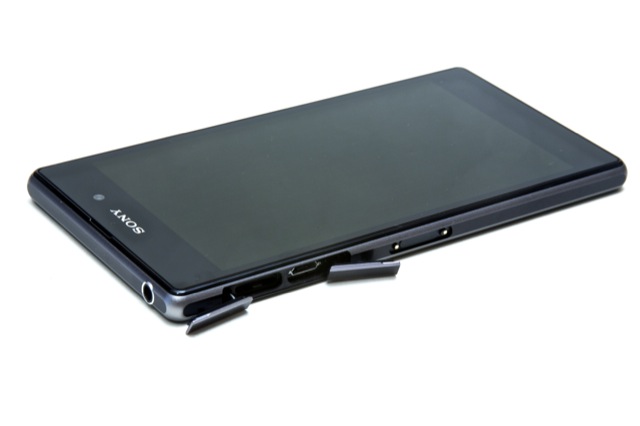
As you can see, due to the design features, it was necessary to increase the number of connectors located “in sight”, however, the plugs were made very carefully and almost imperceptible when closed. On the other hand, the Z1 does not have such a weak spot as the removable back cover. Some people don’t like the relatively wide frame around the display, but there’s a plus here - the number of random clicks of the hand that contains the phone is noticeably reduced.
Despite its solid size, Z1 is very comfortable in the hand (if the hand is not the smallest, of course), does not annoy with sharp corners and does not slip, well, and impressive weight only complements the feeling of solidity and reliability.
Xperia Z1 is equipped with a new five-inch Triluminos display with a resolution of 1920x1080 and a density of 440 ppi. The display is made using OptiContrast technology, eliminating the formation of an air gap and the corresponding distortion. If some people made claims to the Xperia Z screen because of viewing angles, then Z1 is fine with this: when tilted by more than 45 degrees, the colors become slightly dimmer, and the contrast is lower, but this can be seen only when viewing images or video, the text is read without any problems at any inclination, at which in principle it can be seen. The screen has a certain margin of brightness - it makes sense to set it to the maximum only in bright sunlight, while indoors the limit level seems even somewhat excessive. In addition, you can always use the automatic adjustment, which works quite accurately and provides maximum comfort in all conditions. The display works very well with both bright and pastel shades, shows a very good black without a bias in the blue or gray, and there are no complaints about the white color. The X-Reality feature (also used in modern Sony TVs) is designed for complex image enhancement by increasing the saturation, contrast and clarity, as well as reducing noise, while viewing photos and videos does an excellent job and can be turned off if you prefer to see originals.
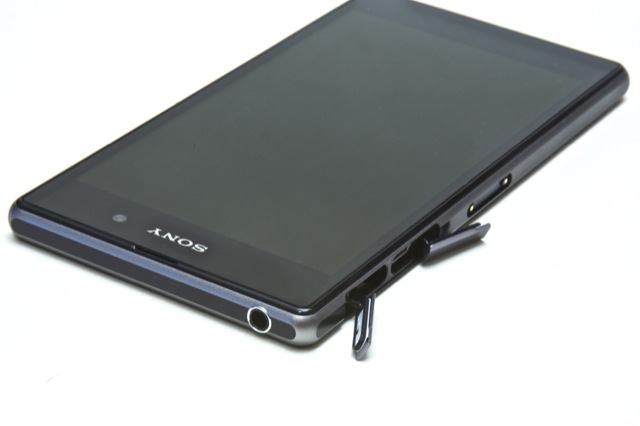
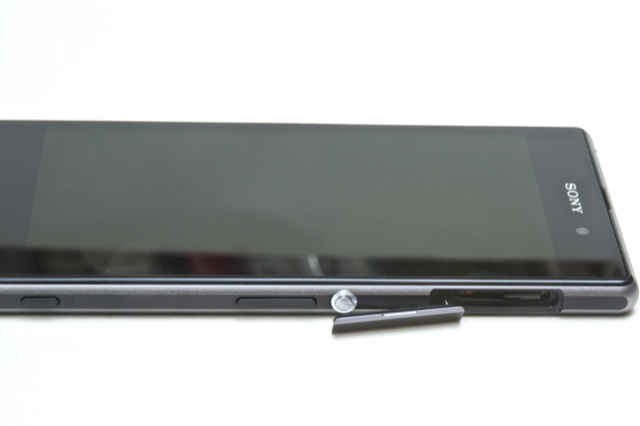
Like other models, the screen (as well as the back panel) is covered with a factory protective film with anti-reflective and oleophobic properties, which, of course, does not completely exclude reflections and the appearance of fingerprints, but glare does not annoy, and the traces are easily removed. The film is very pleasant in the tactile plan and I don’t want to peel it off at all. Over time, of course, it is scratched, but it is easy to replace it with a new one.
The Z1 started talking about the camera long before the release; the last two years, Sony put smartphones on the same camera (in principle, the same cameras (8-megapixel for younger models and 13 for the flagship)), while in Z1 it can boast a completely new 20, 7-megapixel camera with a matrix size of 1 / 2.3 inches, which corresponds to the characteristics of modern compact cameras, in addition, great attention is paid to the 27-mm lens with an aperture of F2.0, made using G-Lens technology, used in professional lenses Sony. It is worth noting the new image processing system BIONZ, which also migrated from professional cameras (used, among other things, in top models like the Sony Alpha 99). What does this give in practice? Very decent dynamic range, natural rich colors, confident shooting in low light, excellent detail and extremely high speed. Please note that in automatic mode, the camera takes 8-megapixel images and its full use is possible only in manual mode. Quick settings allow you to set the white balance and adjust the exposure, and from the advanced options menu, you can select the focus and measurement mode, ISO (50-800 or auto), enable the stabilizer, smile recognition, automatically register faces (indicates photos of people from your contact list) . You can also configure the button’s functions (launch the camera or launch it and immediately take a snapshot), enable automatic uploading of photos to the server and select the drive to save. There was quite an interesting feature Timeshift Burst, which can be useful if you are shooting something dynamic and do not have time to press a button. The camera will already be saved a series of shots from which you can choose the most successful. Panoramic shooting and real-time graphic effects never got to anywhere, augmented reality technology appeared, adding three-dimensional objects to the frame, placed on the assumed planes. Well, finally, now you can add links to various graphic applications directly into the camera interface, so that you don’t switch to them through the desktop once again. Below you can see photos taken in various conditions.






The smartphone is protected from water and dust in accordance with the IP58 standard, that is, it can withstand immersion in water to a depth of one and a half meters for half an hour. Provided, of course, that all plugs are well closed. Interestingly, the headset jack for this model does not close, but bathing does not cause him any harm, but now you need to make less manipulations to connect headphones. Thus, if you use a docking station for charging and use wireless data transmission, you can not open the plugs at all. But I would not drop the Z1 once again, unlike the sturdy Xperia ZR with its thick plastic case, glass, although tempered, can crack if it is in sharp contact with a hard surface. By the way, because of the same glass panels, the phone slides strongly on the table, so it is not recommended to put it close to the edge - a vibrating alert can cause a fall. The screen, although it reacts to wet fingers, under water, of course, will not work, but for underwater shooting you can use a special button that launches the camera.
Sony continues to work to increase the autonomy of mobile devices and with great success. In the summer, many praised the Xperia SP and ZR for extremely high, the operating time for an Android smartphone, in the case of the Z1, the situation is even better - a 3000 mAh battery, perfectly optimized power consumption and the STAMINA mode do their job - even with very intensive use for talking, SMS, reading, surfing the web and listening to music by the end of the day there is still about 50% of the charge. Games, video and navigation, of course, consume more energy, but the situation can be stabilized by the same “Stamina”.
Jokes of the form “my phone is more powerful than the computer on which I work” have finally ceased to be jokes. The Qualcomm Snapdragon 800MSM8974 quad-core processor, 2 GB of RAM and the Adreno 330 graphics accelerator provide excellent performance for any modern applications and games on the FullHD screen, but to mention the standard shell, which works very quickly and smoothly. Everything is fine in the tests too - 3DMark honestly writes that the device is too powerful for the usual test and offers to launch Ice Storm Extreme and Unlimited, where it gives out 17571 points and confidently holds the frame rate around 60 FPS, sagging up to 30 only in the most saturated scenes. With a high load on the video system, the smartphone heats up slightly at the top, but it does not cause any inconvenience. With the results of the other tests, as usual, you can see on the screenshots.
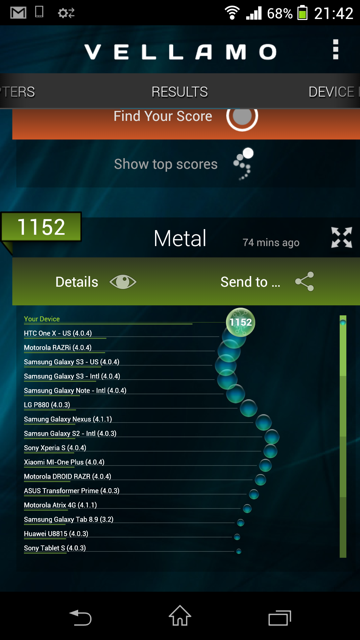
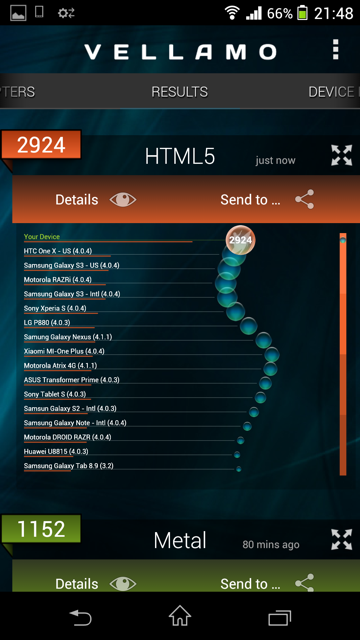
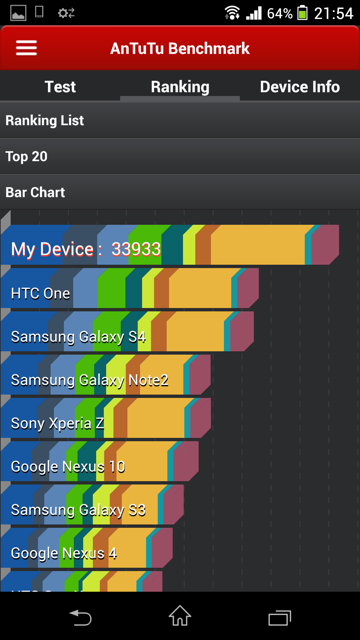
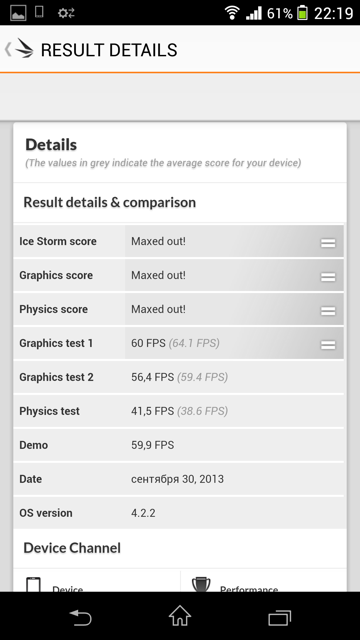
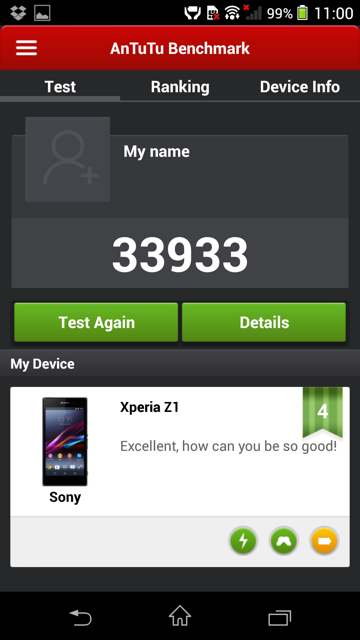
Walkman, familiar to all users of Sony smartphones, has been updated and has become a bit more compact, still knows how to sort music by artist, album and playlist, allows you to add your favorite tracks to Facebook, download tags and covers from the server, and using the Sense Me function you can assign different tracks characteristics (joyful, soothing, energetic, night, etc.) Additional settings are represented by a five-band EQ with presets, volume equalizer, monocompatibility optimizer Clear Phase, xL compressor OUD (they are useful when listening to music through an external speaker) and the complex enhancer ClearAudio +, which combines the functions of a lightweight compressor, an exciter and a stereo widener. However, without all these additions, the sound is very good, the bass is pumping, the tops are clear and transparent, and the middle The music collection located on the SD card is indexed on its own, after which it is added to the player, if the newly downloaded track does not appear there - try to reboot, although this rarely happens.
The external speaker reproduces pretty well everything above 400 Hz, and no one requires a bass from it, you don’t have to complain about the volume (especially if you turn on xLoud), and you even have to turn down the speaker, because at the maximum level too loud.
For two weeks of using the Z1, I never lost a network and did not miss a single call, conversations were not interrupted, sms came and went on time, the Internet worked on all channels like a clock, and navigation worked beyond all praise even on very long routes.
Xperia Z1 comes with the Android 4.2.2 operating system, a proprietary shell and a number of pre-installed applications, such as a file manager, universal social networking clients, Evernote organizer, McAfee antivirus, Opera browsers and Chrome, Office Suite. The shell has changed somewhat for the better. So, for example, in the notification panel buttons appeared for quick controls of WiFi, Bluetooth, 4G, GPS and other services that sometimes need to be turned off. Here you can add additional buttons or remove not that you do not use, you can also change the order of their location. Access to them previously could only be obtained using the settings menu or a special widget, and now in order to, for example, go into airplane mode, you do not even need to unlock the phone.

The device can be called a very worthy change for the Xperia Z. Minor flaws of the previous model were eliminated, and the wishes of users are taken into account. The result was an extremely powerful and very stylish smartphone, thought out to the smallest detail, which is really pleasant and convenient to use, and a choice of three colors will satisfy both lovers of strict style and fashionistas, there will be enough performance for at least a year, and the increased autonomy, perhaps, will finally forget about the idea that you should carry a charger with you.
Processor: Quad-core Qualcomm Snapdragon 800 MSM8974, 2200 MHz
Memory: 2 GB of RAM, 16 MB of internal memory, support for SD cards
Video: Adreno 330
Display: 5 ”, TRILUMINOS, 1920x1080, 16 million colors, scratch protection.
Navigation: GPS, GLONASS
Main camera: Exmor RS 1 / 2.3 ", 20 megapixel
Battery: 3000 mAh, non-removable
OS: Android 4.2
Protection: IP58
Dimensions: 144.4 x 73.9 x 8.5 mm
Weight: 168 g

')
Ergonomics and Design
The body is based on a rigid frame made of a single piece of aluminum and covered with glass panels. By the way, not only external design elements are fixed on this frame, but also the entire filling. Compared to the Xperia Z, the corners have become somewhat more rounded, and just enough to maintain the proper rigor of the design without any hints of “soap”. The layout still corresponds to the concept of OmniBalance: on the right is the traditional round power button, below it is the volume control and a separate button to start the camera. A micro SIM slot closed with a plug settled here. On the right, also under the plugs there is an SD card slot, an MHL connector (combined USB / HDMI), and a two-pin magnetic connector for charging the smartphone through the docking station. The upper end is decorated with a 3.5 mm jack for connecting a headset or headphones, and the lower one is covered with a wide, closed mesh and membrane, speaker. In the lower right corner there is a hole for a strap or some accessory. The indicator light is invisible and located next to the conversational speaker, and on the back panel there is nothing but the camera's eye and the LED flash.


As you can see, due to the design features, it was necessary to increase the number of connectors located “in sight”, however, the plugs were made very carefully and almost imperceptible when closed. On the other hand, the Z1 does not have such a weak spot as the removable back cover. Some people don’t like the relatively wide frame around the display, but there’s a plus here - the number of random clicks of the hand that contains the phone is noticeably reduced.
Despite its solid size, Z1 is very comfortable in the hand (if the hand is not the smallest, of course), does not annoy with sharp corners and does not slip, well, and impressive weight only complements the feeling of solidity and reliability.
Screen
Xperia Z1 is equipped with a new five-inch Triluminos display with a resolution of 1920x1080 and a density of 440 ppi. The display is made using OptiContrast technology, eliminating the formation of an air gap and the corresponding distortion. If some people made claims to the Xperia Z screen because of viewing angles, then Z1 is fine with this: when tilted by more than 45 degrees, the colors become slightly dimmer, and the contrast is lower, but this can be seen only when viewing images or video, the text is read without any problems at any inclination, at which in principle it can be seen. The screen has a certain margin of brightness - it makes sense to set it to the maximum only in bright sunlight, while indoors the limit level seems even somewhat excessive. In addition, you can always use the automatic adjustment, which works quite accurately and provides maximum comfort in all conditions. The display works very well with both bright and pastel shades, shows a very good black without a bias in the blue or gray, and there are no complaints about the white color. The X-Reality feature (also used in modern Sony TVs) is designed for complex image enhancement by increasing the saturation, contrast and clarity, as well as reducing noise, while viewing photos and videos does an excellent job and can be turned off if you prefer to see originals.


Like other models, the screen (as well as the back panel) is covered with a factory protective film with anti-reflective and oleophobic properties, which, of course, does not completely exclude reflections and the appearance of fingerprints, but glare does not annoy, and the traces are easily removed. The film is very pleasant in the tactile plan and I don’t want to peel it off at all. Over time, of course, it is scratched, but it is easy to replace it with a new one.
Camera
The Z1 started talking about the camera long before the release; the last two years, Sony put smartphones on the same camera (in principle, the same cameras (8-megapixel for younger models and 13 for the flagship)), while in Z1 it can boast a completely new 20, 7-megapixel camera with a matrix size of 1 / 2.3 inches, which corresponds to the characteristics of modern compact cameras, in addition, great attention is paid to the 27-mm lens with an aperture of F2.0, made using G-Lens technology, used in professional lenses Sony. It is worth noting the new image processing system BIONZ, which also migrated from professional cameras (used, among other things, in top models like the Sony Alpha 99). What does this give in practice? Very decent dynamic range, natural rich colors, confident shooting in low light, excellent detail and extremely high speed. Please note that in automatic mode, the camera takes 8-megapixel images and its full use is possible only in manual mode. Quick settings allow you to set the white balance and adjust the exposure, and from the advanced options menu, you can select the focus and measurement mode, ISO (50-800 or auto), enable the stabilizer, smile recognition, automatically register faces (indicates photos of people from your contact list) . You can also configure the button’s functions (launch the camera or launch it and immediately take a snapshot), enable automatic uploading of photos to the server and select the drive to save. There was quite an interesting feature Timeshift Burst, which can be useful if you are shooting something dynamic and do not have time to press a button. The camera will already be saved a series of shots from which you can choose the most successful. Panoramic shooting and real-time graphic effects never got to anywhere, augmented reality technology appeared, adding three-dimensional objects to the frame, placed on the assumed planes. Well, finally, now you can add links to various graphic applications directly into the camera interface, so that you don’t switch to them through the desktop once again. Below you can see photos taken in various conditions.






Protection
The smartphone is protected from water and dust in accordance with the IP58 standard, that is, it can withstand immersion in water to a depth of one and a half meters for half an hour. Provided, of course, that all plugs are well closed. Interestingly, the headset jack for this model does not close, but bathing does not cause him any harm, but now you need to make less manipulations to connect headphones. Thus, if you use a docking station for charging and use wireless data transmission, you can not open the plugs at all. But I would not drop the Z1 once again, unlike the sturdy Xperia ZR with its thick plastic case, glass, although tempered, can crack if it is in sharp contact with a hard surface. By the way, because of the same glass panels, the phone slides strongly on the table, so it is not recommended to put it close to the edge - a vibrating alert can cause a fall. The screen, although it reacts to wet fingers, under water, of course, will not work, but for underwater shooting you can use a special button that launches the camera.
Battery
Sony continues to work to increase the autonomy of mobile devices and with great success. In the summer, many praised the Xperia SP and ZR for extremely high, the operating time for an Android smartphone, in the case of the Z1, the situation is even better - a 3000 mAh battery, perfectly optimized power consumption and the STAMINA mode do their job - even with very intensive use for talking, SMS, reading, surfing the web and listening to music by the end of the day there is still about 50% of the charge. Games, video and navigation, of course, consume more energy, but the situation can be stabilized by the same “Stamina”.
Performance
Jokes of the form “my phone is more powerful than the computer on which I work” have finally ceased to be jokes. The Qualcomm Snapdragon 800MSM8974 quad-core processor, 2 GB of RAM and the Adreno 330 graphics accelerator provide excellent performance for any modern applications and games on the FullHD screen, but to mention the standard shell, which works very quickly and smoothly. Everything is fine in the tests too - 3DMark honestly writes that the device is too powerful for the usual test and offers to launch Ice Storm Extreme and Unlimited, where it gives out 17571 points and confidently holds the frame rate around 60 FPS, sagging up to 30 only in the most saturated scenes. With a high load on the video system, the smartphone heats up slightly at the top, but it does not cause any inconvenience. With the results of the other tests, as usual, you can see on the screenshots.





Sound and music
Walkman, familiar to all users of Sony smartphones, has been updated and has become a bit more compact, still knows how to sort music by artist, album and playlist, allows you to add your favorite tracks to Facebook, download tags and covers from the server, and using the Sense Me function you can assign different tracks characteristics (joyful, soothing, energetic, night, etc.) Additional settings are represented by a five-band EQ with presets, volume equalizer, monocompatibility optimizer Clear Phase, xL compressor OUD (they are useful when listening to music through an external speaker) and the complex enhancer ClearAudio +, which combines the functions of a lightweight compressor, an exciter and a stereo widener. However, without all these additions, the sound is very good, the bass is pumping, the tops are clear and transparent, and the middle The music collection located on the SD card is indexed on its own, after which it is added to the player, if the newly downloaded track does not appear there - try to reboot, although this rarely happens.
The external speaker reproduces pretty well everything above 400 Hz, and no one requires a bass from it, you don’t have to complain about the volume (especially if you turn on xLoud), and you even have to turn down the speaker, because at the maximum level too loud.
Connection
For two weeks of using the Z1, I never lost a network and did not miss a single call, conversations were not interrupted, sms came and went on time, the Internet worked on all channels like a clock, and navigation worked beyond all praise even on very long routes.
Software
Xperia Z1 comes with the Android 4.2.2 operating system, a proprietary shell and a number of pre-installed applications, such as a file manager, universal social networking clients, Evernote organizer, McAfee antivirus, Opera browsers and Chrome, Office Suite. The shell has changed somewhat for the better. So, for example, in the notification panel buttons appeared for quick controls of WiFi, Bluetooth, 4G, GPS and other services that sometimes need to be turned off. Here you can add additional buttons or remove not that you do not use, you can also change the order of their location. Access to them previously could only be obtained using the settings menu or a special widget, and now in order to, for example, go into airplane mode, you do not even need to unlock the phone.

Summary
The device can be called a very worthy change for the Xperia Z. Minor flaws of the previous model were eliminated, and the wishes of users are taken into account. The result was an extremely powerful and very stylish smartphone, thought out to the smallest detail, which is really pleasant and convenient to use, and a choice of three colors will satisfy both lovers of strict style and fashionistas, there will be enough performance for at least a year, and the increased autonomy, perhaps, will finally forget about the idea that you should carry a charger with you.
Specifications
Processor: Quad-core Qualcomm Snapdragon 800 MSM8974, 2200 MHz
Memory: 2 GB of RAM, 16 MB of internal memory, support for SD cards
Video: Adreno 330
Display: 5 ”, TRILUMINOS, 1920x1080, 16 million colors, scratch protection.
Navigation: GPS, GLONASS
Main camera: Exmor RS 1 / 2.3 ", 20 megapixel
Battery: 3000 mAh, non-removable
OS: Android 4.2
Protection: IP58
Dimensions: 144.4 x 73.9 x 8.5 mm
Weight: 168 g
Source: https://habr.com/ru/post/196320/
All Articles